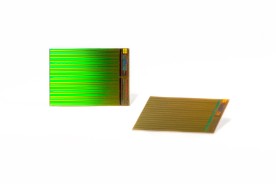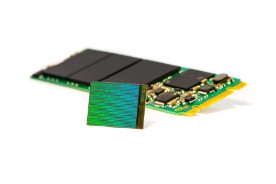(iTers News) - Micron Technology, Inc. and Intel Corporation have jointly taped out a 3D NAND technology, the world's highest-density flash memory, turning up heats in the competition for SSD markets. Flash is the storage technology used inside the lightest laptops, fastest data centers, and nearly every cellphone, tablet and mobile device.
This new 3D NAND technology, which was jointly developed by Intel and Micron, stacks layers of data storage cells vertically with extraordinary precision to create storage devices with three times higher capacity1than competing NAND technologies. This enables more storage in a smaller space, bringing significant cost savings, low power usage and high performance to a range of mobile consumer devices as well as the most demanding enterprise deployments.
Industry leader Samsung Electronics is already producing its own 3D V-NAND flash memory chips in high volume both at its Hwasung fab in Korea an Xian fab in China, while Toshiba and SanDisk are working hard around the clock to tape out their own version of 3D NAND chips sometime in 2015.
The joint rollout by Intel and Micron ushers in fierce competition among the three chip makers to control the potentially huge 3D NAD flash memory chip market, but also promises to accelerate the commoditization of still expensive luxury SSDs, or solid disk drives, as the 3D NAND technology will enable SSD vendors to build small enough and cheap enough to replace current HDDs. Intel says that its 3D NANA flash memory chips boast of three times the capacity of existing 3D NAND technology. What makes different with Samsung Electronics’ 3D NAND is that Intel is using a traditional conductive floating gate as a data storage block, while Samsung's stores data in a non-conductive charged trap circuitry layers.
Enables gum stick-sized SSDs with more than 3.5TB of storage
Planar NAND flash memory is nearing its practical scaling limits, posing significant challenges for the memory industry. 3D NAND technology is poised to make a dramatic impact by keeping flash storage solutions aligned with Moore's Law, the trajectory for continued performance gains and cost savings, driving more widespread use of flash storage.
"Micron and Intel's collaboration has created an industry-leading solid-state storage technology that offers high density, performance and efficiency and is unmatched by any flash today," said Brian Shirley, vice president of Memory Technology and Solutions at Micron Technology. "This 3D NAND technology has the potential to create fundamental market shifts. The depth of the impact that flash has had to date—from smartphones to flash-optimized supercomputing—is really just scratching the surface of what's possible."
"Intel's development efforts with Micron reflect our continued commitment to offer leading and innovative non-volatile memory technologies to the marketplace," said Rob Crooke, senior vice president and general manager, Non-Volatile Memory Solutions Group, Intel Corporation. "The significant improvements in density and cost enabled by our new 3D NAND technology innovation will accelerate solid-state storage in computing platforms."
Innovative Process Architecture
One of the most significant aspects of this technology is in the foundational memory cell itself. Intel and Micron chose to use a floating gate cell, a universally utilized design refined through years of high-volume planar flash manufacturing. This is the first use of a floating gate cell in 3D NAND, which was a key design choice to enable greater performance and increase quality and reliability.
The new 3D NAND technology stacks flash cells vertically in 32 layers to achieve 256Gb multilevel cell (MLC) and 384Gb triple-level cell (TLC) die that fit within a standard package. These capacities can enable gum stick-sized SSDs with more than 3.5TB of storage and standard 2.5-inch SSDs with greater than 10TB. Because capacity is achieved by stacking cells vertically, the individual cell dimensions can be considerably larger. This is expected to increase both performance and endurance and make even the TLC designs well-suited for data center storage.
The key product features of this 3D NAND design include:
Large Capacities –Three times the capacity of existing 3D technology1—up to 48GB of NAND per die—enabling three-fourths of a terabyte to fit in a single fingertip-sized package.
Reduced Cost per GB – First-generation 3D NAND is architected to achieve better cost efficiencies than planar NAND.
Fast – High read/write bandwidth, I/O speeds and random read performance.
Green – New sleep modes enable low-power use by cutting power to inactive NAND die (even when other die in the same package are active), dropping power consumption significantly in standby mode.
Smart – Innovative new features improve latency and increase endurance over previous generations, and also make system integration easier.
The 256Gb MLC version of 3D NAND is sampling with select partners today, and the 384Gb TLC design will be sampling later this spring. The fab production line has already begun initial runs, and both devices will be in full production by the fourth quarter of this year. Both companies are also developing individual lines of SSD solutions based on 3D NAND technology and expect those products to be available within the next year.



